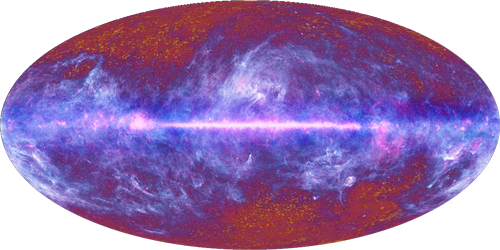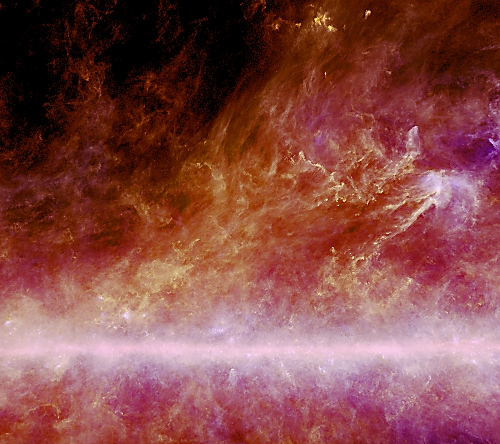
Planck started scanning the sky on 14th August 2009, and is still going 500 days later. Once every minute, Planck has spun on its axis to map rings around the sky. Now well into its third sky survey, Planck is more than half-way through its mission, and is mapping the sky at nine different wavelengths bands ranging from 0.3mm up to 1cm.
Planck’s primary mission is to map the Cosmic Microwave Background, relic radiation from the early Universe, released just 400,000 years after the Big Bang. But the early Universe is not the only object which shines in microwave light. The gas and dust in our own Galaxy glows brightly, clouding the view of the Cosmic Microwave Background. The wide wavelength coverage of Planck is the solution.
By scanning the sky multiple times (click here to see a video), Planck is building up a picture of which components of our Galaxy are seen at each wavelength. In July 2010 Planck’s first all-sky map (shown above-right) was released, showing the power of such wide wavelength coverage. The dust in our Galaxy is shown in blue and white, with gas in pink. This gas and dust is located in the disc of our Galaxy, which is seen edge-on from Earth and makes a band across the centre of this image.

The Cosmic Microwave Background is visible at the top and bottom of the image, looking away from the bright disc of the Galaxy. By comparing the emission seen at all its wavelengths, scientists working on Planck will be able to get a much clearer understanding of the Early Universe. Doing so takes a long time, and these cosmological results are not expected for around two years.
Far from being an inconvenience, astronomers are also studying the dust and gas in our own Galaxy, which mark the places where stars are forming. Images of stars forming in the constellations of Perseus and Orion have been shown, as well as a region towards the centre of the Galaxy (left). Planck is making maps of the star formation on the largest scales, which can be studies in more detail by other telescopes such as the Herschel Space Observatory.
But our own Galaxy is not the only one seen by Planck. In January 2011, a catalogue of the distant galaxies will be released, as well as very localised regions of star formation in our own galaxy. Watch this space for this, and many more results over the next 500 days of Planck’s mission.